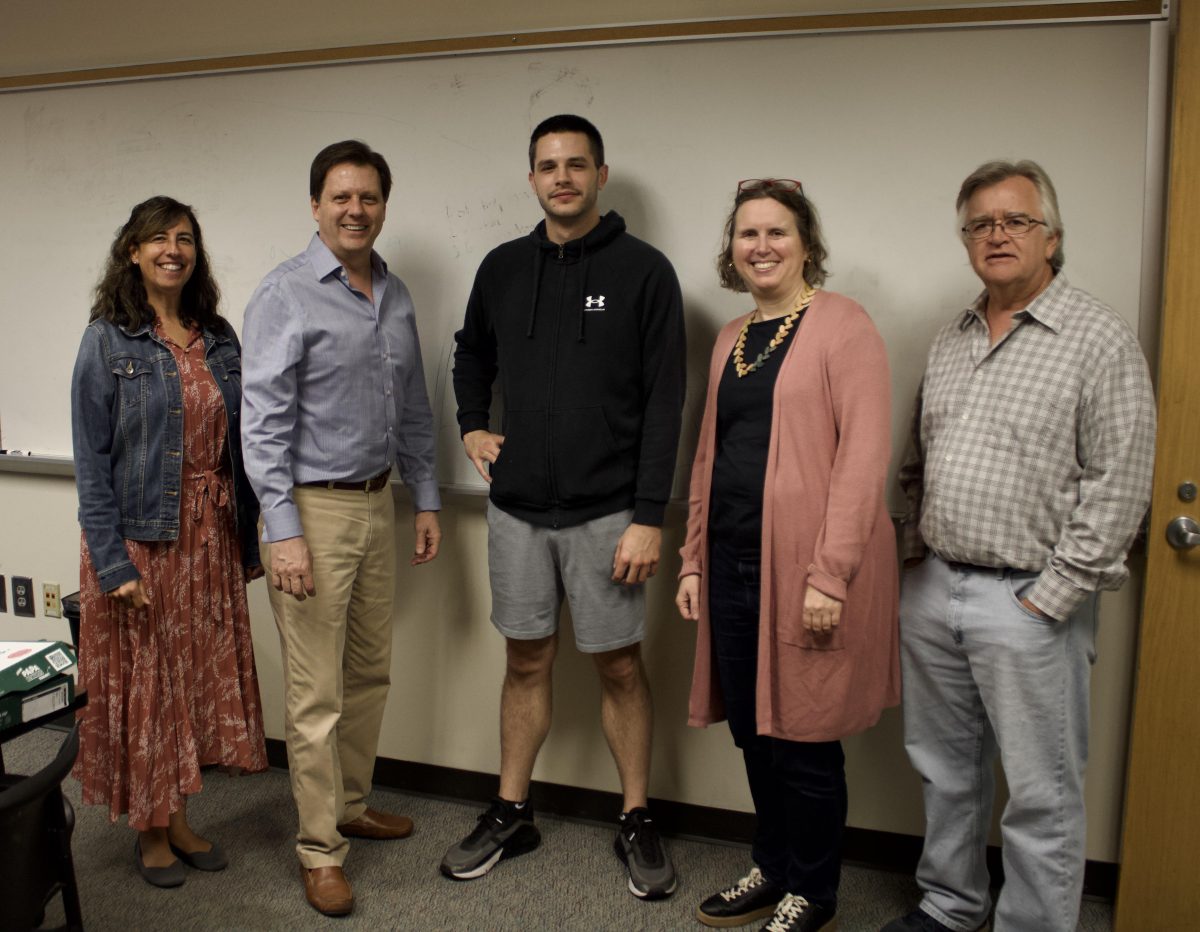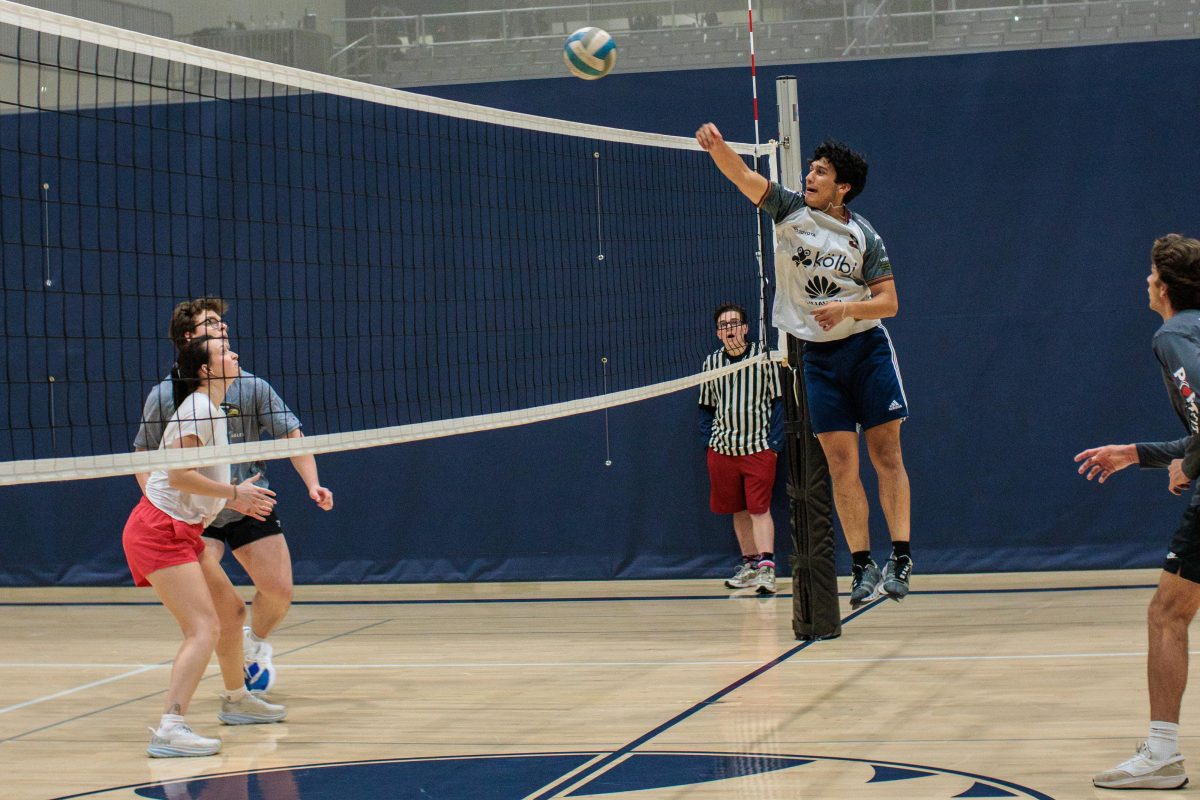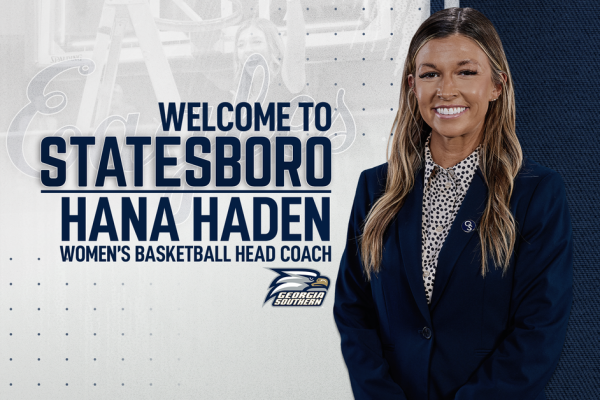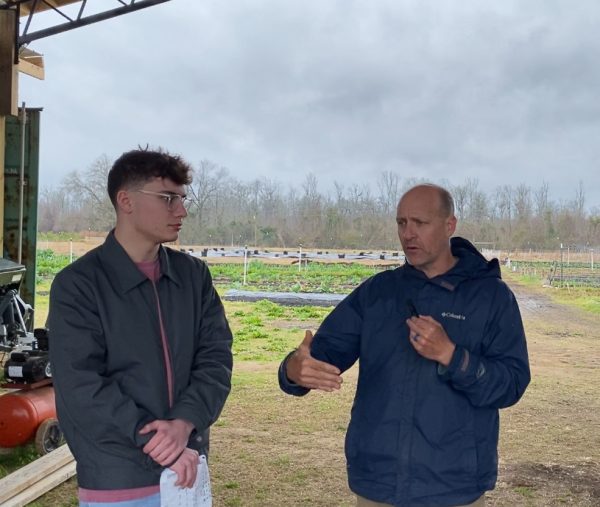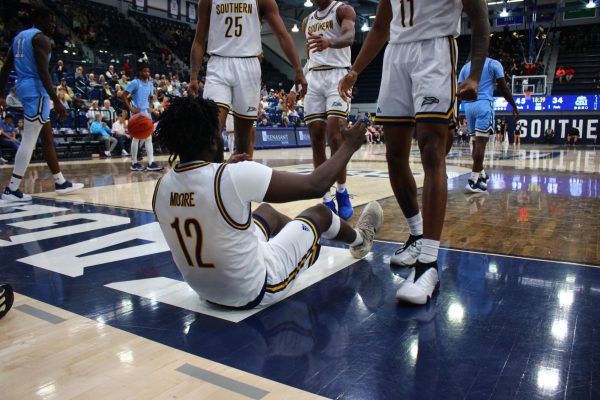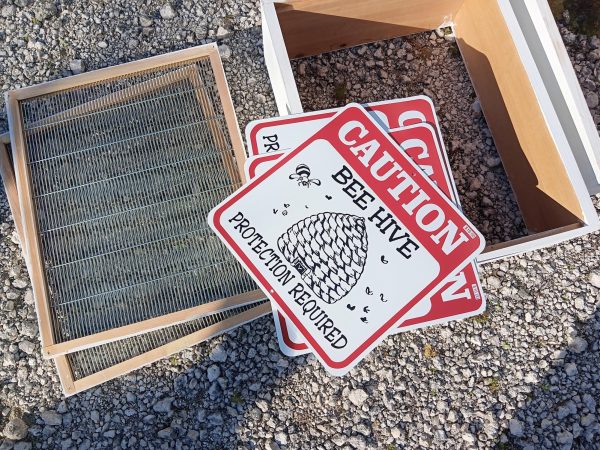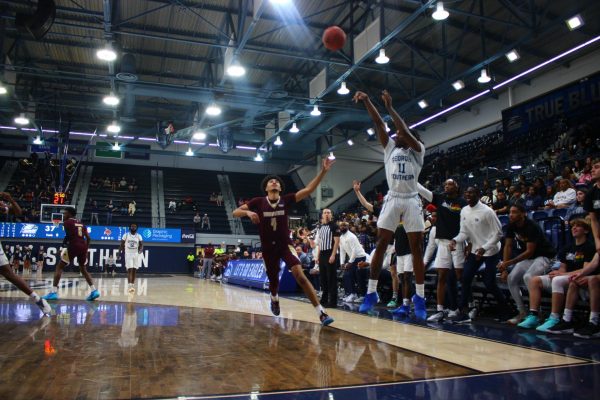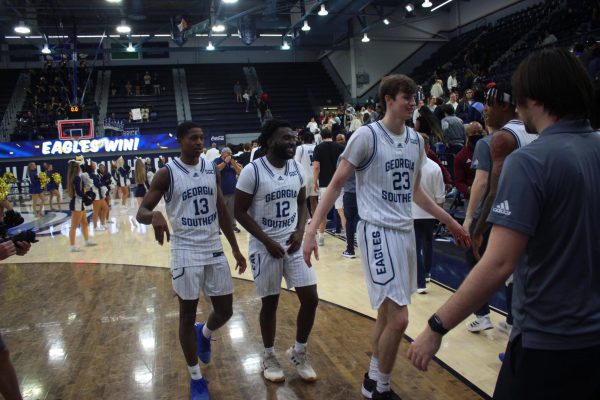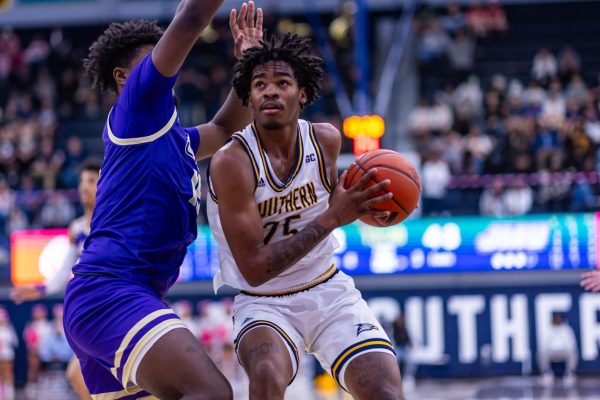Erk Russell is a neat guy
August 13, 2015
Late in the fall, ten or so years ago, a group of comfortably exhausted hunters were sipping Wild Turkey and spooning down a warm beef stew around a fire at a hunting camp a bit east of middle Georgia. In between mouthfuls of the steamy stew and bourbon was the first time I heard his name.
“God, I hated when we had to play y’all then,” Helton, a lifelong Alabama Crimson Tide fan, said. “Didn’t matter how close the game was or if we were winning, once I saw that blood on his big bald head I knew we weren’t gonna win.”
The group of men laughed softly and reminisced further.
“Thank the lord he got tired of waiting on Dooley and left the SEC, I could hear him hollering at the players through the TV, spared us the trouble of marking up a loss before the season started,” said Charlie, a graduate of Alabama Polytechnic Institute (renamed to Auburn University in 1960).
Steve, another Crimson Tide fan, leaned back in his rickety green fold-out chair.
“Yeah, there wasn’t anybody like Erk,” he said.
_______________________
Certainly in the state of Georgia, if not the South as a whole, the first stories heard about Erk Russell are not tales of one of the most effective defenses ever built, or his savant-level football IQ. Not of his membership in every Hall of Fame he qualifies for, national championships or number of All-American players he coached.
The first stories are of school buses, snakes in the locker room, cigars, “beautiful” Eagle Creek and, most of all, bloody foreheads.
Erk Russell is the genesis of all things labeled Georgia Southern tradition. You’d be hard pressed to walk down the pedestrium on campus and not see a pastel-colored T-shirt with his big bald head and quotes plastered on the back. His signature philosophical battle cries “One More Time,” “GATA” and “Do right,” remain the backbone and mottos of Georgia Southern University. Audio of his pregame motivational speeches are ritually shared before students’ finals week arrives.
Like a cultural watermark, his influence transcends the confines of football and sport and is stamped, either physically or metaphorically, on everything Georgia Southern.
_______________________
A few months had passed since then Georgia Southern College (GSC) President Dale Lick announced that football was returning to GSC. Early Monday morning, May 25, 1981, only a short time after midnight, Ric Mandes called Roger Inman with little breath to spare.
“I need you to build a stage to have a press conference on. It needs to have our logo and a football on it, painted and everything. Don’t ask me why, just do it,” Mandes said.
“Got it,” Inman replied.
Of course, despite Mandes’ vaguity, Inman knew exactly what he was building it for. Inman and Mandes were both parts of what is now affectionately known as the “Dirty Dozen.” The group, headed by Athletic Director Bucky Wagner, were the covert force behind the courting of Erk Russell. In the months following President Lick’s announcement of the restoration of four-decade-long absence of football, the press was clamoring over who the little college in the gnat-tarnished land above Savannah would acquire.
Including Erk Russell, the press had a few coaches picked out as “probables,” but the Dirty Dozen had their eyes locked on the already immensely successful Russell.
Inman, the last member of the Dirty Dozen left at Georgia Southern, put together a makeshift stage to be placed in Hanner Fieldhouse at 10 a.m. that morning. Just before the press conference Inman and Wagner realized they didn’t have a football to give Russell for the photographs and had to run down to the sporting goods store minutes before the media frenzy began.
Russell was only five and a half months off of winning a national championship as defensive coordinator at the University of Georgia under the legend Vince Dooley. Russell was, at the time, the consensus heir apparent to Dooley. His defensive philosophy of “If we score, we may win. If they never score, we’ll never lose,” carried UGA to its first national championship title since World War II. What wasn’t apparent at the time was his role to play in the reconstruction of another program that had been dormant since World War II.
“I remember that press conference and building that stage like it was just this morning,” Inman said, laughing, “The paint on the stage was still wet when they were talking all of those photos and speaking.”
_______________________
After the press was gone and the plywood stage moved out of the gym, Russell, Wagner, Lick and the Dirty Dozen were able to shift their focus to the sport they planned to reignite.
At the time of Russell’s official appointment as Head Coach of GSC’s infant football program there were no offices, no coaching staff apart from Russell, no field to play games on, no players, no jerseys, no scheduled games and, most detrimentally, almost no cash to be spent.
The group got to work.
Russell and his cohorts road tripped around the southeast Georgia area, fundraising, cutting deals and drumming up interest in recruiting, despite not yet having scholarships to offer.
The time between the hiring and the fall semester was spent flexing Russell’s starpower for support. Squeezing out every last drop to afford whatever they could.
Eventually, after a handful of months travel in the pounding south Georgia sun, the group got a break in the form of two names that are still synonymous with Georgia Southern football today.
M.C. Anderson, owner of a construction company in the area, pledged $250,000 to create the foundation of a football stadium followed by a $1 million donation from Allen E. Paulson, former owner of Gulfstream, to build the stadium that carries his namesake today.
Shortly after this burst of support Russell did get his first semi-official office. The single-wide construction trailer with a mini fridge and a jacuzzi in the back was a gift from another local construction company.
Inman joked, “I don’t think that office quite met regulation standards.”
_______________________
In late September, 1981, a large group of walk-ons showed up to the first official practice for Erk’s Eagles.
After the first few days of practice concluded Erk spoke to Dan Rahn of the Statesboro Herald about the turnout.
“I tried to picture both extremes of what we could have,” Russell said, “And what we actually have falls somewhere between the two extremes.”
The initial round of athletes fighting for a spot on the team were split between strong high school football players from the surrounding area and unprepared, recreational amateurs.
The Eagles had not yet obtained official varsity football program status and thus were not permitted to schedule games against teams that had. This left Russell and his ragtag team and staff to schedule games against teams like Florida State’s reserve junior varsity team, the Fort Benning Doughboys and even Magnum Force, a team fielded by the Jacksonville, FL police department.
After practice on the third day concluded, Russell was asked how many students showed up for the first practices.
“About 140 players,” Russell replied, smiling. “Excuse me, about 140 people.”
_______________________
“We got ‘em right where we want ‘em, son,” Coach Russell said, grabbing his quarterback by the scruff of his jersey, jogging toward the locker room.
“What game are you watching?” Tracy Ham, quarterback of the 12-2 Eagles, said.
Growing up in Florida, Tracy Ham knew Erk Russell as “the bald-headed guy on the sidelines screaming with blood on his face.” During the recruitment process Ham was told he’d have to convert to running back or linebacker by the big SEC schools recruiting him. His childhood team being the Florida Gators, this was especially frustrating. Ham turned his eyes to Russell and the newly formed Georgia Southern team, in hopes of retaining his prized quarterback position. Luckily for Ham, Russell wasn’t in much of a position to be picky when he recruited him in 1982.
Three years after Russell recruited Ham, and President Lick, Wagner and the Dirty Dozen blew the flames of Georgia Southern’s football program, the Junkyard Dawg and his team had bulldozed their way to the 1-AA National Championship game against Furman University on the back of the offensive coordinator Paul Johnson’s triple-option offense. The offense headed up by quarterback and now College Football Hall of Fame member, Tracy Ham.
At halftime Ham and the Eagles were down 22 points going into halftime. After a season of offensive explosiveness they were held to field goal after field goal.
“Everybody was frustrated,” Ham said, leaning back in his cushy office chair inside Hanner Fieldhouse.
“When we were walking back onto that field after halftime he pushed the ball in my hands and told me, ‘this is your 30 minutes, take it,’” Ham said.
In the second half Ham and the Eagles offense stormed back, eventually leading to a touchdown pass with 10 seconds on the clock to seal the deal for the comeback.
Ham said “That, to me, was the most ‘Erk’ moment I remember. The way he just glared at me, told me we were going to win, when I was in my most vulnerable and frustrated state, that was Erk. That was his approach to football, Georgia Southern, everything. That’s the kind of guy he was. Indomitable.”
Following the 1985 championship win, Russell, now lovingly called “The Bald Eagle,” led to eagles to claiming the 1986 season’s national championship as well, blowing out Arkansas State in the process, planting their foot firmly in the ground as the best team in 1-AA college football.
The already famous head coach had now become one of the most highly touted coaches in college football.
The Georgia Southern College Eagles reached the National Championship game in each year following, with the exception of 1987, until Russell’s dream final season in 1989, which saw the Eagles draw the only 15-0 record in 20th century college football, including another National Championship victory over Stephen Austin University.
_______________________
“We were sitting around the recruiting table at Georgia, 25 years ago, and we brought back reports on height, weight and speed of all the prospects. Every now and then somebody would mention that that prospect’s mama really looks good,” Russell said, and paused. “And everybody said at that time that when prospect’s mamas start looking good you’re getting old. Well folks, about three years ago prospect’s grandmothers started looking good, and I knew it was time.”
The crowd at the evening ceremony boomed with bittersweet laughter. The mighty coach was hanging up the whistle and clipboard just a few months after his team’s perfect 1989 season, capping off an unquantifiably successful career of national championships and unshakable traditions.
Russell remained in Statesboro and worked with the university in a number of ways after his stepping down. He regularly spoke to players, attended pep rallies and, of course, ate at Snooky’s.
_______________________
September 10, 2006, at the most hushed gathering in Paulson Stadium’s history, Erksine “Erk” Russell was laid to rest after a stroke caused him to crash his pickup truck off Cypress Lake Road two days prior. More than 2,000 former players, family and friends attended the 80-year-old coach’s wake in Paulson.
Vince Dooley, Tommy Tuberville, Mark Richt and swarms of other college football dignitaries arrived in Statesboro to honor and pay their respects to the legendary football coach.
“Can I ask you something? Is that allowed?” Inman ask me at the conclusion of our conversation.
“Why did you come to school here? Georgia Southern,” Inman said.
I didn’t have much of an answer. I blurted, “I’m not sure, definitely not the heat.”
Inman laughed, “Let me ask you another question,” he insisted.
“Do you think you’d be here if Erk Russell didn’t come here first?”
Once again, I didn’t have much in the way of an answer. I responded with a quick “probably not,” and clicked the recorder off.
Upon thinking about it, looking at where Georgia Southern was before Russell and where we’re at now, the answer becomes resolutely clear.
No, I would not have come to Georgia Southern University if Erk Russell hadn’t achieved what he did just three short decades before my arrival. I’m not a betting man, but I would wager that the probability of the quaint, 4,200 student Georgia Southern College evolving into the 22,000 student juggernaut Georgia Southern University without the coach whose statue stands seven-and-a-half feet tall outside our football stadium is relatively low.
“I’m gonna’ get out of here while I’m still alive. I’m gonna’ say it one more time. We’re Georgia Southern. Our colors are blue and white. We call ourselves the bald eagles. We call our offense the Georgia Power Company, and that’s a terrific name for an offense. And our snap count is ‘Rate-Hike.’ We practice on the banks of beautiful Eagle Creek, and that’s in Statesboro, Georgia, the gnat capital of America. Our weekends begin on Thursday. The coeds outnumber the men three to two, and they’re all good lookin’ and they’re all rich. And folks, you just can’t beat that, and you just can’t beat Georgia Southern. And you ain’t seen nothin’ yet.” -Erk Russell

